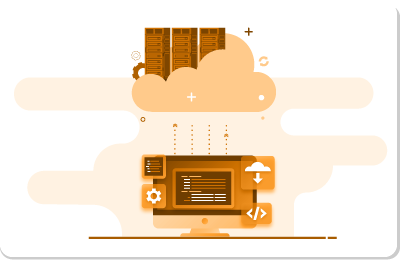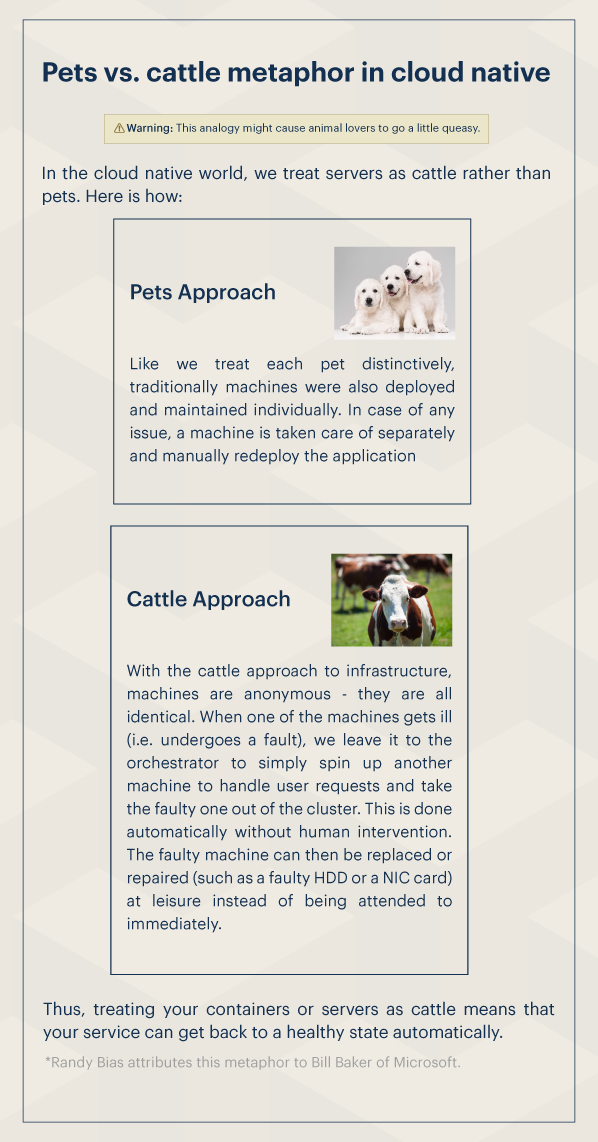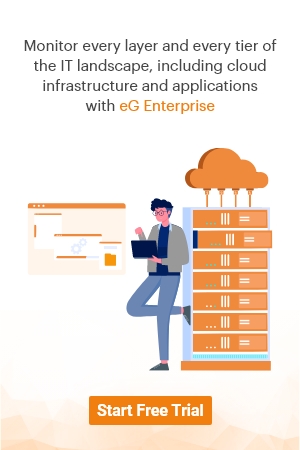The What and The Why of Cloud Native Applications – An Introductory Guide
Cloud native applications can be a useful tool in an environment where organizations across most industries are under tremendous pressure to develop and deploy IT applications and services faster and with far greater efficiency. Traditional enterprise application development falls short since it is not efficient and speedy.
IT and business leaders are keen to take advantage of cloud computing as it offers businesses cost savings, scalability at the touch of a button, and flexibility to respond quickly to change. Today, cloud native has altered the approach to developing, shipping, and managing software applications. It has quickly emerged as an innovative concept that is in smooth alignment with business requirements.
This article will help you understand:
- What are cloud native applications?
- How cloud native apps differ from traditional enterprise applications
- Business drivers and benefits of cloud native applications
- The need for performance monitoring in a cloud native environment
What are Cloud Native Applications?
“Cloud native” refers to the process of development, implementation, deployment, and functioning of applications that fully reaps the benefits of the cloud computing model.
The key aspects that characterize cloud native applications are:
- They are built as a collection of loosely coupled, business-capability-oriented services
- These services are packaged in containers, deployed as microservices, and managed on elastic infrastructure with an orchestrator to manage these containers.
- Such elastic infrastructure could be anywhere: public, private, hybrid, or multi-cloud.
- Operations teams use DevOps processes, fully automated continuous integration, and continuous delivery pipelines (CI/CD) to ensure that applications are automated, scalable, resilient, manageable, and observable.
Official definition of Cloud Native from Cloud Native Computing Foundation
Cloud native computing uses an open-source software stack to deploy applications as microservices, packaging each part into its own container, and dynamically orchestrating those containers to optimize resource utilization..
These techniques enable loosely coupled systems that are resilient, manageable, and observable. Combined with robust automation, they allow engineers to make high-impact changes frequently and predictably with minimal toil.
What makes the cloud ideal for cloud native applications?
Any significant cloud platform—public, private, or otherwise provides a set of capabilities to help realize the modern cloud native applications. Bill Wilder outlines a set of characteristics of a cloud platform in his seminal book ‘Cloud architecture patterns’:
- Cloud scaling is horizontal: You have the illusion of infinite resources that are only limited by the maximum capacity of individual virtual machines.
- Short-term resource rental model: Cloud scaling makes resources available as effortlessly as they are added.
- Metered pay-for-use model: Cost and payments for cloud applications are transparent as they are based on current resource requirements, allocations, and usage
- Automatable: Enabled by self-service, on-demand, programmatic provisioning, and releasing of resources, cloud scaling is automatable.
- Expect and designed for failures: Cloud applications are optimized for cost rather than reliability as they are enabled and constrained by multi-tenant functions working on commodity hardware.
- Rich ecosystem: Cloud application development is simplified due to a rich ecosystem of managed platform services for virtual machines, data storage, communication, and networking.
While the journey to cloud native is technology-intensive, there’s a growing school of thought that it’s a lot more than technology. Teams should pay attention to establishing the right culture to fully reap the benefits of cloud native.
The culture adopted in cloud native tends to embrace learning and continuous improvement. Teams need to adopt self-education, experimentation, and data-backed research in a rapidly changing technology landscape—more about cultural principles in a later section below.
Comparison of Traditional vs. Cloud Native Applications
The following business drivers influence the choice of cloud native applications:
- Always up – Applications must always be up with zero downtime. They must be resilient to infrastructure failures and changes, whether planned or unplanned.
- Shorter interval from keyboard to production – Business wants the end-to-end process to happen quickly. The code developers create the capital, and the intent is to have it in the customers’ hands as quickly as possible. Another goal is to release frequently since faster iterations are less risky.
- Anywhere and any device – Users access applications from their mobile devices they carry with them 24/7. In addition, industrial sensors send a large amount of data to servers. Both scenarios result in a high request volume that could fluctuate wildly. Applications, therefore, need to scale dynamically and continue to function adequately.
Five Core Principles of Cloud Native Architecture
Whether you create an architectural design for physical, on-premises, or cloud native architectures, the framework remains similar. However, certain basic presumptions change on the adoption of the cloud. For instance, replacing a server would take weeks within a traditional environment but seconds in a Cloud Native Application. Hence, it is essential to understand specific characteristics of cloud native apps to leverage the benefits of the cloud.
Microservices
When a monolithic application is broken into many smaller pieces (i.e. independent applications/services), it becomes easier to scale those specific parts of the processing that are constrained by scalability or performance. These smaller pieces are called microservices. Each microservice is designed to be autonomous, independent, and self-contained.
This approach has several advantages: Each microservice can be deployed, upgraded, scaled, and restarted independent of other services in the application and with no impact on the end-user. Because they are independent, you eliminate dependencies and coordination effort. Teams can work in parallel, thereby increasing velocity.
A key attribute of microservices design is that they should be stateless. Data is externalized – it is stored in state stores such as storage services. This feature enables elasticity, which is one of the key attributes of cloud computing.
The twelve-factor methodology is set of application development principles that applications should implement to take advantage of the common practices of modern cloud platforms.
Containerization
While microservices are essential in designing and developing cloud native applications, containers are important in the packaging and running cloud native applications. The microservices are built and grouped into container images and deployed to a host operating system.
A container is a running process isolated from the host operating system and other processes in the system. Bundling a cloud native application into a single, contained unit with all libraries, configuration files, executables, or other components that the application needs to execute is enabled through containerization. This process makes applications easy to test, move, and deploy.
Containerization (using technologies such as Docker or Podman) also makes cloud native applications immutable. In a nutshell, containers can be started or stopped at a moment’s notice and can remove any defective instances instead of being fixed or upgraded. More on immutability is in the sections below. More on immutability is in the sections below.
Orchestration
To manage the life cycle of containers at scale, you need to use a container orchestrator. The tasks of a container orchestrator are the following:
- The provisioning and deployment of containers onto the cluster nodes
- Resource management of containers – placing containers on nodes that provide sufficient resources or moving containers to other nodes if the resource limits of a node are reached
- Health monitoring of the containers and the nodes and rescheduling in case of failures on a container or node level
- Scaling in or scaling out containers within a cluster – adding and subtracting containers to deal with the load.
- Providing mappings for containers to connect to overlay networks and dynamic firewalls
- Internal load balancing between containers – both within a node and across multiple nodes.
In the cloud native landscape, Kubernetes has become the de facto container orchestration system.
Dynamic provisioning
Cloud platforms allow the compute, network, memory, and storage resources to be provisioned on-demand, using standardized APIs, without up-front costs—and in real-time response to real business needs.
Traditionally, capacity planning and provisioning of hardware resources are very cost-intensive. In the cloud, a team of engineers can start deploying value to production in a matter of hours. Resources can also be de-allocated just as quickly, closely mirroring changes in customer demand.
Letting your chosen cloud platform run things dynamically means resource life cycles get managed automatically and according to unwaveringly high availability, reliability, and security standards.
Automation
Common areas for automating cloud native applications are:
- Continuous integration (CI) and Continuous Delivery (CD)
- Infrastructure as Code
- Automatic cloud scaling
- Monitoring and observability
CI and CD
The core premise of cloud native is to have a working build of the system daily. That way, feedback is immediate. Mistakes are corrected as they are made. The idea is to integrate early and integrate often.
When developers push their changes into a central source-control repository such as Git, it automatically triggers the continuous integration (CI) process. The application code is built and test automation ensures that any errors are surfaced immediately. If all goes well, the application then gets packaged into a binary. In summary, source code integration coupled with automated build management and verification tests makes up CI.
Continuous deployment (CD) allows the automation of the delivery of binary packages to the production environment. CD also adds an automated step after the package has been posted to the repository to install the new version of the package to production. The process also needs to include an automated monitoring process that can determine if the application deployment was successful and trigger a rollback if required.
Adopting CI/CD practices allows organizations to quickly iterate and improve an application, releasing new features or fixing existing bugs. Tools like Jenkins and Spinnaker can help with CI/CD.
Infrastructure as Code
The core principle is to create reproducible infrastructure at the click of a button by treating Infrastructure as Code (IaC). Teams codify all the instructions necessary to ensure environments are automatically provisioned, consistent, and repeatable. This process is a significant shift from the traditional practice of build, deploy, patch and maintain, which were time-consuming and error-prone. Tools such as Terraform, Pulumi, and cloud vendor tools such as AWS CDK can help with this effort.
Another core premise in cloud native is immutable infrastructure. The term is borrowed from the programming concept of immutability. That is, once you instantiate something, you never change it. Along the same vein, infrastructure is replaced rather than maintained.
In the data center, infrastructure is expensive. To preserve the investments, ops teams craft and carefully maintain each individual server. In contrast, the cloud provides the capability to set up new infrastructure at the click of a button – better still, in an API call that is invoked in an automated way.
Automatic cloud scaling
Teams automate the scale-up of the system when the load increases and scale down when there is a sustained drop in load. These steps ensure that the service remains available with steady and predictable performance during high load and optimal cost when the load eases off. Examples include Auto Scaling Groups (ASGs) on AWS, managed instance groups on Google Cloud Platform, or Scale Sets on Azure.
Deployment strategies in Cloud Native
There are two major deployment strategies:
- Blue/green deployment: Involves side by side deployment of two applications, i.e., current (blue) and new (green). While the green environment is for testing the blue one is for production.Once the testing is done the routers are switched and user traffic is shifted from blue to green. This not only allows for a quick fallback but also helps eliminate downtime. However, running both versions simultaneously can be expensive.
- Canary deployment: Entails the practice of sending a small fraction of traffic to newly deployed workloads and then gradually ramping up all the traffic flows.Like a canaries left in a coal mine to judge survival rate, a handful of containers are exposed to production. If successful, it is rolled out and if not, the damage is minimal.
Service meshes (such as Istio or Linkerd) provide advanced routing features to complement the above deployment strategies.
Monitoring and observability
Application Performance Monitoring services are essential during all stages of the cloud native process; however, it’s imperative during the release stage when applications are deployed into production. Teams bake monitoring into cloud applications from the inception as opposed to an afterthought. Business stakeholders can obtain valuable insights into user behavior and experience – how many people are using which parts of the application from various geographical locations and their average response time, and so forth. Site Reliability Engineers (SRE) spearhead observability efforts by combining monitoring metrics (such as error rate, incoming request rate, latency, and utilization) with other sources of information (such as logs, application tracing) to obtain an overall view of the system health.
Automation brings many advantages:
- When team members are trapped in performing mundane tasks, they can’t use their talent to solve new and more complex challenges.
- Infrastructure as code allows versions and outcomes to be tracked. It also prevents configuration drift in the environment’s configuration. Small changes on each server grow over time, and teams cannot determine each server’s state (and how each server got into that state). The immutable infrastructure allows servers to be destroyed and rebuilt, thus preventing server configuration from drifting away from a baseline configuration.
- The risk of new changes is mitigated because if a change fails, automated rollback is easy.
- The cloud also provides fail-safety in the event of a regional disruption. If one region is experiencing service issues, the cloud native platform can seamlessly switch to another region with minimal disruption to users.
Cloud Native and DevOps Culture
We talked about culture being center stage in cloud native application development. Here are some typical features of a cloud native/ DevOps culture:
- Shared responsibility: Dev and Ops jointly sign off on any launch before it happens. Teams are given the tools, training, and discretion they need to safely make changes, then deploy and monitor them as autonomously as possible. Both developers (Dev) and operations (Ops) share the on-call responsibility (24×7 support). When a problem happens, everyone gets paged.
- Automation and monitoring: Applications are not allowed to launch unless automated testing and monitoring are in place at the user experience, application, and infrastructure level.
- Guardrails for experiments: The cloud allows for experiments and game days. Teams perform controlled, safe, and observed experiments that allow them to observe how well their application responds to real-world turbulent conditions. This provides valuable feedback to fine-tune runbooks and incident response procedures.
- Environment consistency: Production environments are mirrored by identical staging environments. With containers and orchestration tools, this is relatively easier to accomplish than traditional enterprise applications. Ensuring consistency in environments reduces accidents in production.
- Collaboration: Ops is invited to code reviews. Design and code functionality are no longer just Dev functions. In the same vein, Ops performs regular infrastructure reviews to which Dev is involved. Dev contributes to decisions about the underlying infrastructure. The concept of ChatOps is a key enabler in establishing communication channels for discussions on strategic (application architecture, sizing) and operational issues.
Why Cloud Native Is Important – Key Benefits
A cloud native architecture is appealing to enterprises on account of the benefits it has to offer.
The table below summarizes the IT and business benefits of cloud native applications.
| Traditional → Cloud native technology used | Benefits – IT and Business |
|---|---|
| Legacy enterprise tech stack → Loosely Coupled Micro Services |
IT Benefits
Business benefits
|
| Gigantic binaries tied to the OS → Portable containers |
IT Benefits
Business benefits
|
| Manual deployment and tracking in spreadsheets → Container orchestration platforms like Kubernetes |
IT Benefits
Business benefits
|
| Manual commissioning and decommissioning of systems → Elastic infrastructure |
IT Benefits
Business benefits
|
| Sequential, waterfall model → DevOps processes and CI/CD workflows |
IT Benefits
Business benefits
|
The Need for Application Performance Monitoring (APM) Services
While cloud native applications introduce agility and efficiency, there are also more components involved and several interactions between the different components of an application. Further, compared to traditional enterprise applications, the components in cloud native apps are transitory or fleeting.
All of this makes it essential for IT teams to monitor their applications 24×7 and ensure that the applications are working well and delivering the quality of service that users expect. Diagnosing the problem and detecting the root cause is another big challenge when performance issues are detected. Observability is essential: metrics, traces, and logs all must be analyzed. Analytics for interpreting patterns in the data collected and other AIOps technologies are required to assist IT teams in troubleshooting performance problems.
eG Enterprise is an Observability solution for Modern IT. Monitor digital workspaces,
web applications, SaaS services, cloud and containers from a single pane of glass.
Key Takeaways
- Cloud native applications are here to stay. New applications are likely to use cloud native technologies for agility and efficiency benefits
- Migrating existing applications to adopt cloud native applications requires a significant effort. As a business decision, cloud native application may not be the best option for every situation and is always guided by technical judgement. Importantly, it is usually most cost-effective to architect new applications to be cloud native. Organizations will need to consider the trade-off between cost, effort, and time involved in the migration vs. efficiency and savings from moving to a cloud native architecture. Check out our previous blog on cloud migration.
- Performance monitoring becomes more important when you have cloud native applications. Look for tools that provide observability and AIOps capabilities to help you handle the performance of cloud native applications.














 Arun is Head of Products, Container & Cloud Performance Monitoring at eG Innovations. Over a 20+ year career, Arun has worked in roles including development, architecture and ops across multiple verticals such as banking, e-commerce and telco. An early adopter of APM products since the mid 2000s, his focus has predominantly been on performance tuning and monitoring of large-scale distributed applications.
Arun is Head of Products, Container & Cloud Performance Monitoring at eG Innovations. Over a 20+ year career, Arun has worked in roles including development, architecture and ops across multiple verticals such as banking, e-commerce and telco. An early adopter of APM products since the mid 2000s, his focus has predominantly been on performance tuning and monitoring of large-scale distributed applications. 



